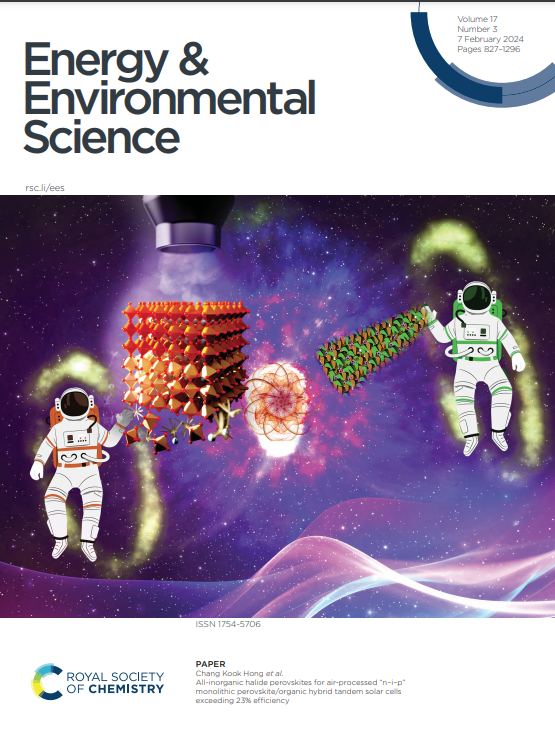Tailoring Multilayer Fine-Grained Solid Electrolyte Interphase by Pulse Electrochemical Activation Maneuver for Stable Si/C Anodes
IF 32.4
1区 材料科学
Q1 CHEMISTRY, MULTIDISCIPLINARY
引用次数: 0
Abstract
Silicon (Si) is widely regarded as one of the most promising anode materials for lithium-ion batteries due to its exceptionally high specific capacity. However, the significant volumetric changes (up to 400%) of Si anode degrades the solid-electrolyte interphase (SEI) and significantly hinders its practical application. Herein, we modulate the formation of fine-grained SEI composed of multiple layers by pulse electrochemical activation mode, where each layer is uniformly distributed with fine inorganic particles and interspersed with buffer organics. This tailored multilayer fine-grained SEI effectively promotes the lithium-ion diffusion kinetics through SEI featuring a small Gibbs free energy (0.235 eV), which is only 1/5 of the typical double-layer SEI, as well as smaller charge transfer resistances during the whole electrochemical processes. Moreover, it exhibits a high Young’s modulus of 12.5 GPa in comparison to that of the typical double-layer SEI (5.1 GPa) and much-inhibited stress and strain, so as to generate lower thickness expansion/shrinkage ratios. Consequently, the assembled Si/C || LiFePO4 full cell, operating at a current density of 1 A g−1, demonstrates a remarkable capacity retention of 93.6% after 583 cycles, which also shows a practical application by powering an unmanned aircraft. This interfacial engineering maneuver sheds light on enhancing the electrochemical performance of other high-capacity electrode materials with substantial volume changes.用脉冲电化学激活机动为稳定的Si/C阳极定制多层细晶固体电解质界面
硅(Si)由于具有极高的比容量而被广泛认为是最有前途的锂离子电池负极材料之一。然而,硅阳极体积的显著变化(高达400%)使固-电解质界面(SEI)降解,严重阻碍了其实际应用。本文通过脉冲电化学激活方式调控多层细粒度SEI的形成,其中每层均匀分布有细小的无机颗粒,并点缀有缓冲有机物。这种定制的多层细粒度SEI有效地促进了锂离子的扩散动力学,其吉布斯自由能(0.235 eV)很小,仅为典型双层SEI的1/5,并且整个电化学过程中的电荷转移电阻更小。此外,与典型的双层SEI (5.1 GPa)相比,它具有12.5 GPa的高杨氏模量,并且应力应变得到了很好的抑制,从而产生了更低的厚度膨胀/收缩比。因此,组装的Si/C || LiFePO4全电池在1 a g−1的电流密度下工作,在583次循环后的容量保持率为93.6%,这也显示了在无人驾驶飞机上的实际应用。这种界面工程操作有助于通过大幅度改变体积来提高其他高容量电极材料的电化学性能。
本文章由计算机程序翻译,如有差异,请以英文原文为准。
求助全文
约1分钟内获得全文
求助全文
来源期刊

Energy & Environmental Science
化学-工程:化工
CiteScore
50.50
自引率
2.20%
发文量
349
审稿时长
2.2 months
期刊介绍:
Energy & Environmental Science, a peer-reviewed scientific journal, publishes original research and review articles covering interdisciplinary topics in the (bio)chemical and (bio)physical sciences, as well as chemical engineering disciplines. Published monthly by the Royal Society of Chemistry (RSC), a not-for-profit publisher, Energy & Environmental Science is recognized as a leading journal. It boasts an impressive impact factor of 8.500 as of 2009, ranking 8th among 140 journals in the category "Chemistry, Multidisciplinary," second among 71 journals in "Energy & Fuels," second among 128 journals in "Engineering, Chemical," and first among 181 scientific journals in "Environmental Sciences."
Energy & Environmental Science publishes various types of articles, including Research Papers (original scientific work), Review Articles, Perspectives, and Minireviews (feature review-type articles of broad interest), Communications (original scientific work of an urgent nature), Opinions (personal, often speculative viewpoints or hypotheses on current topics), and Analysis Articles (in-depth examination of energy-related issues).
 求助内容:
求助内容: 应助结果提醒方式:
应助结果提醒方式:


